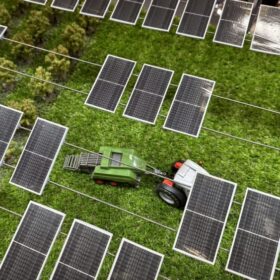Scientists from the Université de Sherbrooke in Canada have fabricated a prototype of a concentrator photovoltaic (CPV) module based on the so-called surface-mount technology (SMT) – a technique that is commonly used to mount electronic components to the surface of a printed circuit board (PCB).
The proposed SMT design used no wire bonding for cell emitter connection and is intended to increase heat dissipation in the CPV panel, which in turn reduces its operating temperature and increases its performance.
“The SMT, which uses a conductive solder paste for interconnection, has the advantage of being less expensive and faster for large-scale production, and SMT equipment takes up less space than wire-based wiring equipment,” they explained. “We have developed and employed the SMT process, which integrates assembly flexibility and enhanced alignment of solar cells, to assemble the solar cells larger than a millimeter in size.”
The 4-solar cell CPV module prototype uses a Fresnel lens to concentrate light onto cells soldered on a transparent glass PCB and protected by lamination layers. The emitter contacts are soldered through conductive solder joints to a glass PCB, which embeds metal tracks for the non-soldered areas. Transparent underfill fills the gap between the solar cell and the PCB to prevent reflections at the interfaces of the module’s bottom plate.
“Underfill fillets protect the sides of the solar cell to prevent short circuits and contribute to the thermomechanical stability of the assembly,” the research team stated. “The back face of the assembly is laminated with an EVA encapsulant and a Tedlar protective sheet to preserve the solar cells from the environment.”

The four cells used in the device are non-interconnected with each other, and are triple-junction III-V germanium solar cells, each with an active surface area of 8.751 mm2. The cost of solar cells based on compounds of III-V element materials, named according to the groups of the periodic table that they belong to, has confined the devices to niche applications, such as drones and satellites. These are applications where low weight and high efficiency are more pressing concerns than costs.
The scientists mounted the 4-cell CPV SMT module on a 2-axis solar tracker from the Helios platform at the University of Sherbrooke.

The group took a series of electrical and temperature measurements on the system under real operating conditions and also conducted a series of simulations based on the finite element model (FEM), which is a numerical technique used to perform finite element analysis (FEA) of physical phenomenon.
Through their analysis and experiments, the academics found that the dimensions of the metal ribbon at the back of each cell and the metal coverage ratio of the PCB are key factors for the thermal management of the CPV module, while the other components have a negligible impact on the module temperature.
“The temperature of the solar cell can be kept below 80 C over a wide range of dimensions of the metal ribbon behind the solar cell, both for a metal coverage of the PCB of 0 % or 100 %,” they further explained. “However, this dimensional range is much wider when the metal coverage ratio is 100 % than when the metal coverage ratio on the PCB is 0 %.” The simulation also showed that the temperature of the solar cells may reach 54 C with a copper ribbon and 57 C with an aluminum ribbon.
The system was described in the paper “Finite element modeling and experimental validation of concentrator photovoltaic module based on surface Mount technology,” published in Solar Energy Materials and Solar Cells. “These results demonstrate that in addition to simplifying the assembly process, using SMT for CPV modules fabrication can enhance heat dissipation both by the metallic layer on the glass PCB and on the back side contact,” the researchers concluded. “This opens the door to simpler CPV modules, higher performance CPV modules and higher concentration ratios.”
This content is protected by copyright and may not be reused. If you want to cooperate with us and would like to reuse some of our content, please contact: editors@pv-magazine.com.









By submitting this form you agree to pv magazine using your data for the purposes of publishing your comment.
Your personal data will only be disclosed or otherwise transmitted to third parties for the purposes of spam filtering or if this is necessary for technical maintenance of the website. Any other transfer to third parties will not take place unless this is justified on the basis of applicable data protection regulations or if pv magazine is legally obliged to do so.
You may revoke this consent at any time with effect for the future, in which case your personal data will be deleted immediately. Otherwise, your data will be deleted if pv magazine has processed your request or the purpose of data storage is fulfilled.
Further information on data privacy can be found in our Data Protection Policy.